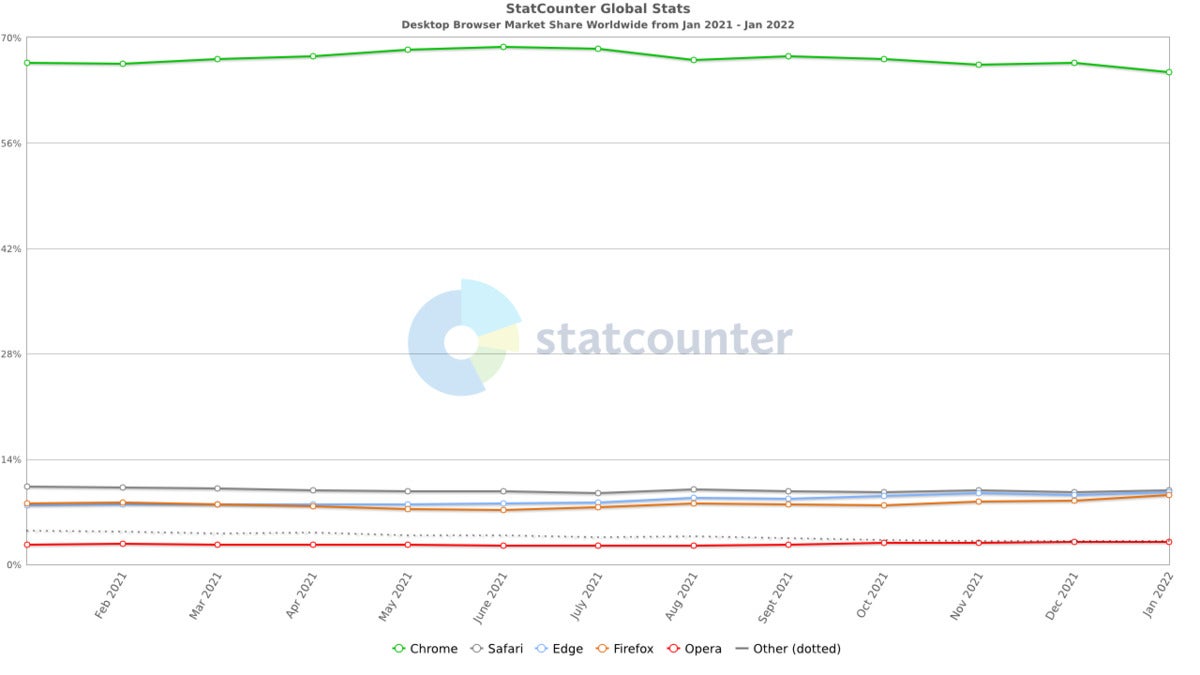Microsoft Edge is now used on 9.54% of desktops worldwide, just behind Safari at 9.84%, according to data published this week by web analytics service StatCounter. It’s the highest market share for Edge reported by StatCounter to date.
Google Chrome still holds the top spot by a long shot at 65.38%, with Mozilla Firefox bringing up the rear with 9.18% market share. The new data was first reported by TechRadar.
 StatCounter
StatCounterEdge’s lead on other browsers differs greatly depending on location. For example, in the US, Edge is well behind Safari — Edge has just 12.1% market share while Safari claims 18.2%. In Europe and Asia, Edge has already passed Safari, with 10.9% and 7.46%, respectively. Apple’s Safari runs on 9.95% of desktops in Europe and just 5.41% of desktops in Asia.
All in all, Edge is now a worthy competitor to Goggle Chrome, with rivals such as Firefox apparently losing the limited popularity they already had, according to Jack Gold, president and principal analyst at J. Gold Associates.
In 2020, Microsoft relaunched Edge, recasting it with Google’s dominant Chromium technology; it’s the same browser code that powers Chrome. Not only did Microsoft make Edge a Chrome copy, it also expanded support to versions of Windows other than 10, including macOS and Linux.
"For one thing, when Microsoft switched to a Chromium engine, Edge got a lot faster and more compatible with more websites that, because of the preponderance of Google Chrome browsers, were built to be compatible with Chrome and not the older Edge (it had some unique requirements for full compatibility)," Gold said.
Microsoft also upped Edge's game around security and privacy, Gold said. And, while it’s not perfect, it does "a pretty good job of filtering out all the garbage people throw at you when browsing.
"And the link to Microsoft security helps with keeping away malware and malicious sites. But of course, Microsoft also has the advantage of putting Edge on every Windows machine, so there is a natural built-in use case for people who don’t want to bother with downloading an alternative," Gold added.
Of course, Safari’s lane is as a default browser on the Apple iPhone and iPad tablet. On those devices, it’s a very different story. Chrome has 46.3%, Safari nets 39.4%, and Android claims just 12.6% of traffic.
Some web analytics services already have Edge surpassing all other browsers except the ever-dominant Chrome. For example, Net MarketShare’s most recent data has Chrome at 69% market share, Edge at 7.75%, and Firefox at 7.48%. Safari is a distant fourth, with just 3.73%.
Safari’s popularity in some quarters may, in fact, be waning — if Twitter comments can be a measurement of its popularity.
Earlier this month, an Apple employee who advocates for Safari developers got an eyeful after taking to Twitter to ask users for feedback on why the Safari browser is unpopular and to ask that they point out specific issues with it.
Jen Simmons, an Apple evangelist and developer advocate on the Web Developer Experience team for Safari and WebKit, was clearly taken aback by the responses.
“Catching up with tech Twitter this morning and there seems to be an angry pocket of men who really want Safari to just go away,” Simmons tweeted. “Do we really want to live in a 95% Chromium browser world? That would be a horrible future for the web. We need more voices, not fewer.”
Unlike some rival browsers, such as Firefox, Apple's updates to Safari are sparse, with major upgrades just once a year. So the bulk of new features are often rolled out in a single instance. While that may be appealing for some who dislike frequent browser updates, it also means upgrades and/or fixes for Safari don’t come often.
In recent years, however, Safari has borne a raft of complaints about the browser's bugs, user interface and experience, and website compatibility, according to MacRumors. Last June, Apple unveiled a substantial redesign of Safari at the company's Worldwide Developer Conference (WWDC). Many of those changes, however, were met with quick criticism describing them as "counterintuitive."
Apple went through several iterations of the browser during the summer — both on mobile devices and desktops — and allowed users to largely revert to the previous Safari design prior to the release of iOS 15, iPadOS 15, and macOS Monterey.
"Everyone in my mentions [is] saying Safari is the worst, it's the new IE,” Simmons tweeted.
Hoping to get to the bottom of the anger, Simmons asked Twitter users to point to specific bugs and missing support that frustrate them or make it harder for them to create websites or apps. “Bonus points for links to tickets,” she wrote.
“Specifics we can fix. Vague hate is honestly super counterproductive,” she added.






